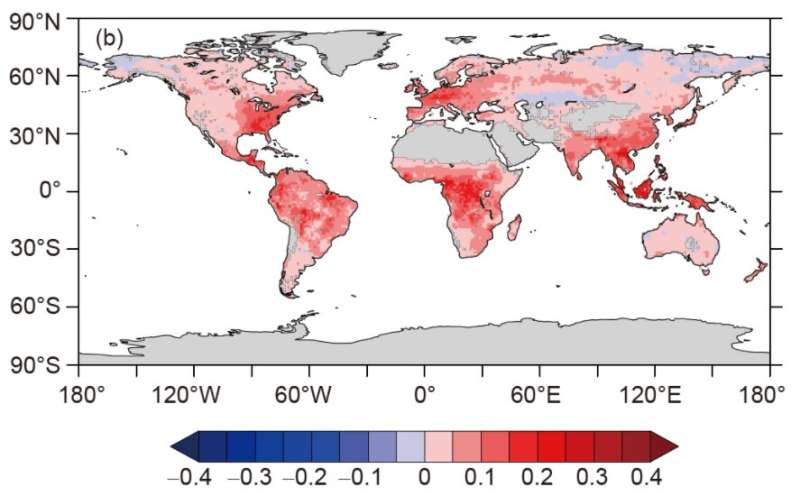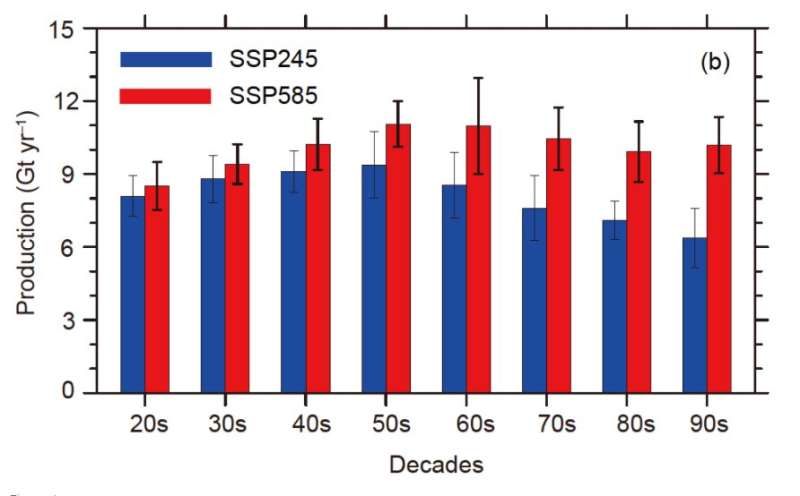Study finds future terrestrial ecosystem will produce more oxygen for the atmosphere

In a study led by Dr. Lei Ding and Prof. Jianping Huang (College of Atmospheric Sciences, Lanzhou University), researchers found the future terrestrial ecosystem will produce more oxygen for atmosphere when exploring the variation of the modern oxygen cycle.
"Oxygen cycle is an essential biogeochemical cycle for all aerobic life on Earth. However, the modern oxygen cycle has experienced a drastic change compared with that in pre-industrial period," Huang says. This change is characterized by the decline in atmospheric oxygen (O2) level, which continued for recent decades.
As a main component of oxygen cycle, the terrestrial ecosystem had attracted the researchers' attention. To determine the response of ecosystem O2 production to climate change and anthropogenic activities, the research group developed a long-term global terrestrial ecosystem O2 production database.
They found that, as the largest O2 source on Earth, terrestrial ecosystem can produce more than 80% of the total O2 production (7.10 Gt from land, 1.74 Gt from ocean). The main O2 sources are located in the tropics, and the O2 production decrease as the latitudes increase.
The team also found, in the future, the terrestrial ecosystem O2 productions will experience a significant increase, which may slow down the decline of atmospheric O2 level. "With the increase in net photosynthesis of vegetation, more O2 will be emitted into atmosphere," Ding says.

Long-term analysis reveals that anthropogenic activities and climate change are responsible for the variations in terrestrial O2 sources, owing to land-use changes and competing effects between net photosynthesis and heterotrophic respiration. By 2100, more O2 will be produced from the low and middle latitudes, while the high latitudes will serve as a larger oxygen sink due to extreme land-use type changes and drastic increases in soil respiration.
"The increase of terrestrial O2 production will partly compensate for the loss of O2 in the atmosphere. However, we must stress that this situation is still not optimistic, as the amount of O2 consumed by fossil fuel combustion is also increasing to unprecedented levels. If we rely entirely on ecosystem adaptation and recovery without reducing or limiting fuel combustion and other anthropogenic activities, the O2 concentration will continue to decline," Huang says.
This study of O2 production in terrestrial ecosystems complements the understanding of the modern oxygen cycle and helps provide better estimates for future variations in atmospheric O2 level. Moreover, the integrated long-term global terrestrial ecosystem production database provides a new tool for assessing ecosystem health.
The research was published in Science China Earth Sciences.
More information: Lei Ding et al, Variations in terrestrial oxygen sources under climate change, Science China Earth Sciences (2022). DOI: 10.1007/s11430-021-9956-5
Journal information: Science China Earth Sciences
Provided by Science China Press



















